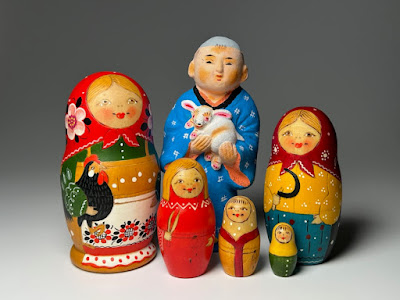小幡人形 Obata Doll
鮮やかな水色の着物を着た少年がうさぎを抱いている。よくある郷土人形に比べてお顔がとてもリアルに描かれているとおもう。からだがちょっと斜めに傾いているがそれがまたリアルだ。いっぽうでうさぎの顔はかなりデフォルメされていて、その対照がおもしろい。うさぎは多産で昔から縁起物とされていて、古伊万里の図柄でも定番だ。なにか厄除けとか招福などの意味がこのうさぎの顔にこめられているのかもしれない。
A boy wearing a sky blue kimono holds a rabbit. The facial expression is realistic compared to other Japanese folk dolls. The doll's appearance is made more realistic by the body's slight slant. It is interesting that the rabbit's face is quite deformed. Since rabbits have numerous babies, they have long been regarded as a lucky animal. I guess people found meanings of warding off evils and inviting good luck in the rabbit's face.
The face with red cheeks is attractive. The kimono pattern is finely drawn even in the back.
この土人形は滋賀県五個荘町(現・東近江市)小幡在住の細居源悟氏の作品で、製作地の名前から小幡人形とよばれている。昔はこういった人形のことを「でこ」と言ったので「小幡でこ」とも称される。小幡でこの歴史は古く、18世紀はじめ頃にさかのぼる。創始者の細居安兵衛からいまの源悟氏まで、約300年間、九代にわたって伝統が受け継がれているというから大したものだ。くわしくはホームページを参照のこと。
This clay doll was created by Hosoi Gengo who lives in Obata, Gokasyo, Shiga Prefecture, Japan, and is keeping the tradition of the Obata doll. He is the 9th master of the Obata doll studio, if counting from Hosoi Yasubei who began manufacturing dolls in Obata 300 years ago.
A snapshot showing friendship between Japan and Russia.
ところでうちにはマトリョーシカが一体あって、その一番大きな女性はにわとりを抱いている(上の写真)。にわとりは卵をたくさん産むので子だくさんのうさぎと共通点がある。他の少女は鎌やはさみをもっているので、子孫繁栄や勤勉さの象徴としてこうした図柄を人形に描いたのかもしれない。日本とロシアの人々がおなじように人形に願いをこめているようで興味深い。なおこのマトリョーシカは現代の作家さんの作品だが、100年くらい前の古いマトリョーシカを踏襲したもので、ウッドバーニングやニスの種類など、製作方法も古作に習っているようだ。
By the way, I have a matryoshka, and the largest woman holds a hen. Rabbit and hen have a common characteristic of prolificacy. I guess Japanese and Russian people hoped family's health and permanence in a similar way, believing these dolls saved children.



